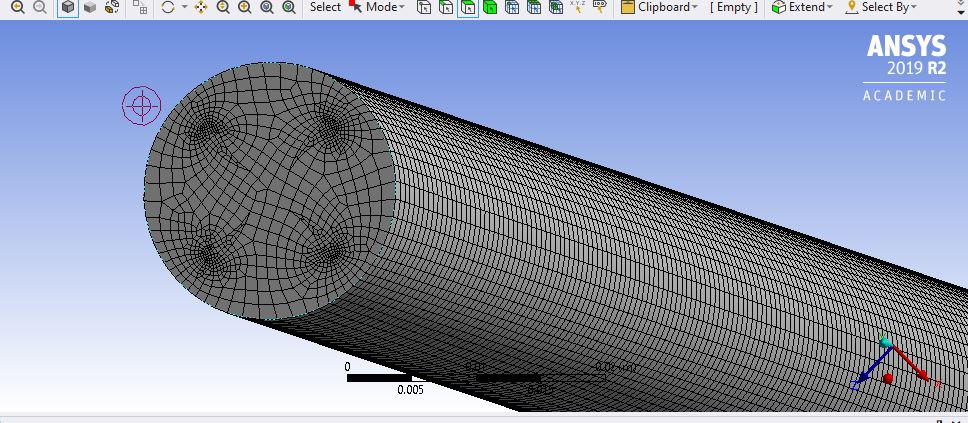-
-
March 6, 2021 at 4:24 pm
snr1
SubscriberThis query is mainly intended to know the effect of momentum equation spatial discretization scheme on the solution and convergence history.nA simulation was converged with 1st order upwind momentum discretization scheme but it is not converging with the other high order schemes.nWhat might be the reason for this? how to get good convergence with the high order schemes in this situation?nCan we consider the lower scheme order solution as final solution of the simulation?n -
March 6, 2021 at 10:33 pm
YasserSelima
SubscriberDecrease the under relaxation factors. And check the box, use higher order relaxation. If you are doing unsteady simulation, decrease the time step and increase the number of iterations in every time step. If running steady, Pseudo transient is a good option.nDepending on the application. If you are using this to test theory or to make a draft design, yes ... but if you want to publish this data or to optimise a design, no. n -
March 7, 2021 at 6:27 am
snr1
SubscriberDear YassernI decreased the URF, enabled the higher order relaxation and pseudo transient formulation. But, still my residuals are not decreasing. In present case, whenever i change the material properties, the residuals are not decreasing. Means the material properties are influencing the convergence history. In this case how we can make the case to converged solution?n -
March 7, 2021 at 12:33 pm
YasserSelima
SubscriberWhen you run First-order with a set material properties, you get a good preliminary solution. Then, when you use higher order terms, you are refining the solution.nWhen you change the properties after obtaining the preliminary solution, the problem becomes a different problem. And your preliminary solution might not be valid.nCan you show your mesh? and the residuals plotn -
March 8, 2021 at 5:12 am
snr1
SubscriberAfter getting the preliminary solution (i.e. converged solution) with first order scheme, i used second order schemes, which leads to non-convergent solution.nI am not changing the properties at all while switching the discretization schemes. i.e. the properties are same for both first order and high order schemes.nMesh:n n
n n.Residualsn
n.Residualsn n5.Temperature profilen
n5.Temperature profilen n
n
-
March 8, 2021 at 7:52 am
Amine Ben Hadj Ali
Ansys EmployeeActually you should never on an arbitrary mesh publish or quantify results coming from a first order runs. Saying that one also needs to note that high order schemes are more prone to wiggles and stability issues but this can be mitigated by for example starting from first order run results and continuing iterating or using HOTR in Fluent or even relaxing a bit the the blending between first order and second order schemes.nn -
March 8, 2021 at 8:56 am
snr1
SubscriberI am not using an arbitrary mesh and i have tried the above said methods except the blending. In all the cases, the results are not converging with higher order schemes whereas solution is getting converged in first order scheme.n -
March 8, 2021 at 1:06 pm
YasserSelima
SubscriberThis is converged solution. You have residuals converging and reaching constant value. The monitored value reached steady state.nThe reason you are not getting lower residuals could be the nature of the problem. When you try steady simulation of a case that is unsteady by nature.nn -
March 8, 2021 at 2:36 pm
Amine Ben Hadj Ali
Ansys EmployeeThe residual you are using are global scaled which are level dependent and also depend on the URF's etc ( I recommend to use local scaling for residual to have better judgment in general). But as stated by Yasser: if all other quantities are converging (monitor points, imbalances,..) then you might have already a good solution. Residual are only showing how the solution might change relative to solution of previous iterations and it does contain a lot of scaling. You might perhaps also consider looking into the raw residual without any scalingn -
March 8, 2021 at 4:42 pm
snr1
SubscriberFrom the pictures, we can say that the simulation was converged. Even, the monitored value also reached steady state value. Apart from the temperature, I am also monitoring another value (Swirl number), which is varying based on the iteration number though it has reached steady state as seen from the above. How to tackle this issue?n
-
Viewing 9 reply threads
- The topic ‘Effect of Momentum equation spatial discretization scheme on the solution’ is closed to new replies.
Innovation Space


Trending discussions


- air flow in and out of computer case
- Varying Bond model parameters to mimic soil particle cohesion/stiction
- Eroded Mass due to Erosion of Soil Particles by Fluids
- I am doing a corona simulation. But particles are not spreading.
- Centrifugal Fan Analysis for Determination of Characteristic Curve
- Guidance needed for Conjugate Heat Transfer Analysis for a 3s3p Li-ion Battery
- Issue to compile a UDF in ANSYS Fluent
- JACOBI Convergence Issue in ANSYS AQWA
- affinity not set
- Resuming SAG Mill Simulation with New Particle Batch in Rocky
Top Contributors


-
4117
-
1487
-
1318
-
1157
-
1021
Top Rated Tags


© 2025 Copyright ANSYS, Inc. All rights reserved.
Ansys does not support the usage of unauthorized Ansys software. Please visit www.ansys.com to obtain an official distribution.







